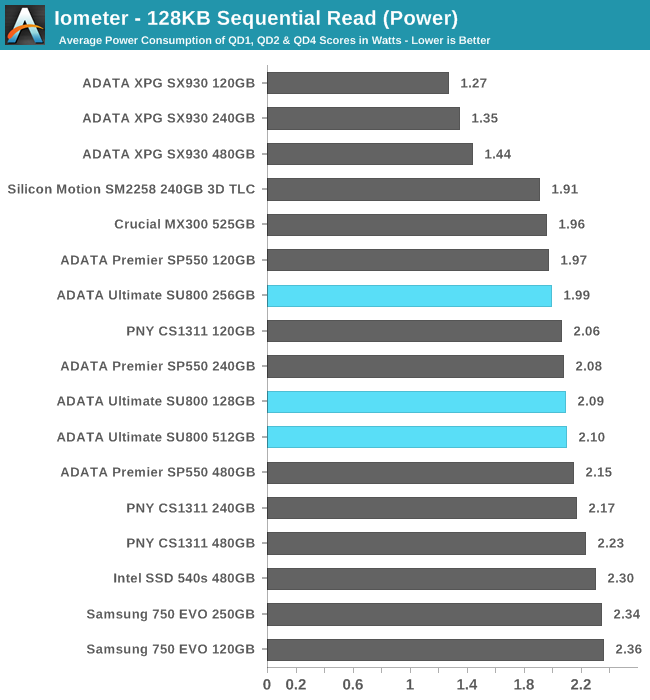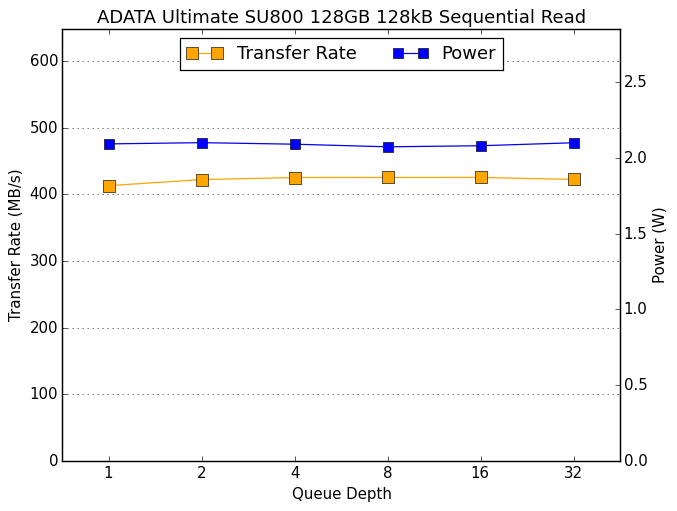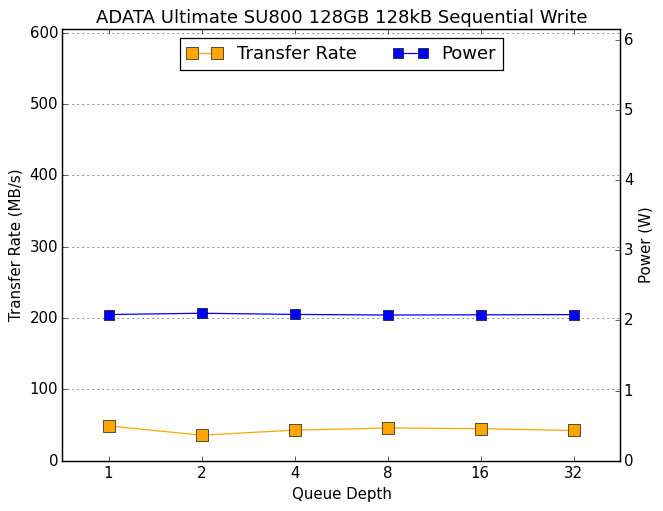The ADATA Ultimate SU800 SSD Review (128GB, 256GB, 512GB)
by Billy Tallis on February 1, 2017 12:01 PM ESTSequential Read Performance
The sequential read test requests 128kB blocks and tests queue depths ranging from 1 to 32. The queue depth is doubled every three minutes, for a total test duration of 18 minutes. The test spans the entire drive, and the drive is filled before the test begins. The primary score we report is an average of performances at queue depths 1, 2 and 4, as client usage typically consists mostly of low queue depth operations.

The smallest capacity of the ADATA SU800 has the slowest sequential read speed of all the drives in this comparison, as it only has flash connected to three of the controller's four channels. The larger SU800s saturate the SATA connection.

The SU800's power consumption is middle of the road for TLC drives, giving the larger two capacities slightly better than average efficiency. The ADATA XPG SX930 demonstrates that MLC NAND flash still has a significant efficiency advantage.
 |
|||||||||
The larger two capacities of the SU800 show modest performance improvement across the first half of the test, while the 128GB model exhibits almost no scaling.
Sequential Write Performance
The sequential write test writes 128kB blocks and tests queue depths ranging from 1 to 32. The queue depth is doubled every three minutes, for a total test duration of 18 minutes. The test spans the entire drive, and the drive is filled before the test begins. The primary score we report is an average of performances at queue depths 1, 2 and 4, as client usage typically consists mostly of low queue depth operations.

The sustained sequential write speeds of the SU800 are quite poor, but this is no surprise after seeing how much a full drive hurt performance on the ATSB Heavy and Light tests.

Power consumption is at least better than average, so the SU800 isn't too far behind the average for efficiency.
 |
|||||||||
Aside from the initial effects of filling up the SLC cache, performance and power consumption during sequential writes don't scale with queue depth on the SU800.










35 Comments
View All Comments
lopri - Thursday, February 2, 2017 - link
I kind of mixed SATA interface with mechanical hard drive in the above post. My mistake.Neeson - Thursday, February 2, 2017 - link
I personally use 512GB SU800 now. With the SLC, the read/write performance is excellent. Especially, when I play games, SU800 NEVER slows down. ADATA SU800 can perform pretty well and the price is right. I like it. (Sharing my own experience)lopri - Thursday, February 2, 2017 - link
The drives look like a decent upgrade option for those who are on mechanical drives or earlier generation of SSDs. I like the thorough review as well as the value assessment. Nevertheless the product is a yawner for tech savvy consumers because it has really no distinguishing feature. I guess the actual market price will be the sole determining factor.realbabilu - Friday, February 3, 2017 - link
Any clue entry ssd vs sshd drives. I want to update my laptopjhon1616 - Thursday, December 27, 2018 - link
Adata Su800 512Gb TBW is 400TB if is baaed on same chips of micron that is cruicial mx300 how can be it 400TB since mx300 525gb tbw is 160tb it is very confusing or ADATA JUST CHANGED SPECS THAT IS INVALID